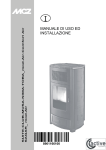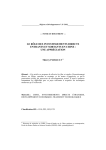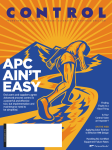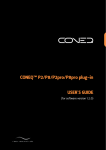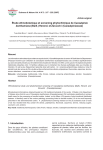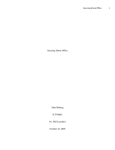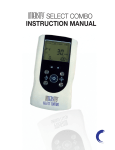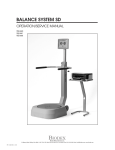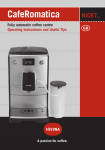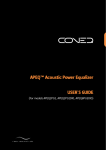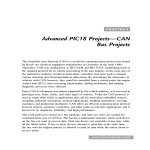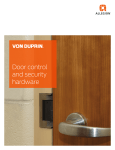Download ZeoBase, a database for zeolite-type crystal structures User manual
Transcript
ZeoBase, a database for zeolite-type crystal structures User manual Werner H. Baur (Western Springs) and Reinhard X. Fischer (Bremen) beta-version July 2013 1 ZeoBase manual beta-version July 2013 1. Introduction ........................................................................................................................ 3 1.1 General information ..................................................................................................... 3 1.2 Database contents ........................................................................................................ 3 1.3 Standardized crystal data ............................................................................................. 3 1.4 Licensing and Copyright, © 2013 by Werner H. Baur and Reinhard X. Fischer ........ 6 1.5 Disclaimer .................................................................................................................... 7 2. Installation of ZeoBase....................................................................................................... 7 3. Program handling ............................................................................................................... 8 3.1 Starting ZeoBase.......................................................................................................... 8 3.2 Retrieve options ........................................................................................................... 9 3.2.1 Overview .............................................................................................................. 9 3.2.2. Framework type code (FTC) ................................................................................ 9 3.2.3 Zeolite Name ...................................................................................................... 10 3.2.4 Bibliographic data .............................................................................................. 10 3.2.5 Keywords ........................................................................................................... 11 3.2.6. Chemical composition ........................................................................................ 13 3.2.7 Unit-cell parameters ........................................................................................... 13 3.2.8 Framework density ............................................................................................. 14 3.2.9 Space-group symmetry ....................................................................................... 14 3.2.10 Distances and angles .......................................................................................... 15 3.2.11 Crystal system .................................................................................................... 15 3.3 List of selections ........................................................................................................ 16 3.4 Edit/view menu .......................................................................................................... 18 3.4.1 Overview ............................................................................................................ 18 3.4.2 Bibliographic data .............................................................................................. 18 3.4.3 Crystal data ......................................................................................................... 19 3.4.4 Lattice parameters, Atomic coordinates, Atomic coord. HTML, Sample data, Comments, TO distances, TO dist HTML table .............................................................. 20 3.4.5 Zeobase.out, zeograph.out .................................................................................. 20 3.5 Histograms ................................................................................................................. 20 3.6 XY-plots .................................................................................................................... 22 3.7 Tools .......................................................................................................................... 24 3.7.1 Distances and angles .......................................................................................... 24 3.7.2 SADIAN ............................................................................................................. 24 3.7.3 STRUPLO .......................................................................................................... 24 3.7.4 Powder pattern.................................................................................................... 24 3.7.5 BRASS ............................................................................................................... 25 3.8 Export ........................................................................................................................ 25 3.8.1 cif ........................................................................................................................ 25 3.8.2 SADIAN ............................................................................................................. 25 3.8.3 STRUPLO .......................................................................................................... 25 3.8.4 Save active frame ............................................................................................... 25 3.9 Print ........................................................................................................................... 25 3.10 Help ........................................................................................................................ 25 4. References ........................................................................................................................ 26 5. Appendix .......................................................................................................................... 27 5.1 Journal codes ............................................................................................................. 27 5.2 Hot keys (shortcuts) ................................................................................................... 32 5.3 File assignments ........................................................................................................ 33 2 ZeoBase manual beta-version July 2013 1. Introduction 1.1 General information ZeoBase is a database for crystal chemical data of compounds with zeolite-type crystal structures. It currently contains more than 5,500 entries of crystal-structure determinations. For more than 4,700 of them the complete crystallographic information is available (space group, unit-cell dimensions, atomic coordinates, chemical composition) and it includes comments concerning the sources of the studied samples. In addition, within each zeolite framework type all entries are fully standardized (see 1.2). The standardization procedure allows the easy comparison of structural parameters and the unambiguous assignment of framework atoms to their sub- and supergroup counterparts, without being limited by spacegroup symmetry or settings [1-3]. Thus this set of crystal structure data provides information uniquely useful for the correlation of a host of structural and physico-chemical relationships. Crystal structure data have been compiled by us for more than twenty years. We strive for a complete collection of all available crystal-structure determinations of zeolites. Presently, ZeoBase encompasses more zeolite entries than any other database. About 50% of the entries are edited, corrected, or emended in a review process, that is documented in comments accessed in Edit/view (see 3.4.4). ZeoBase is an evaluated compilation. Crystal-structure data are entered into ZeoBase whenever the published information is sufficient to calculate the bond distances and angles for the structure and/or a powder pattern can be obtained. If certain data are missing in the original papers for these purposes they are supplied either by contacting the original authors or by guessing the requisite data from the internal evidence of the papers whenever this is possible. Crystal and chemical data can be correlated and displayed in histograms or XY-plots. This is made possible by the standardization of crystal data comprising unit-cell settings, sequence of atoms, and atom names. 1.2 Database contents ZeoBase is searchable for the following properties: zeolite name, framework-type code, author, year of publication, unit-cell parameters and volume, framework density, space group, crystal system, T-O distances and their estimated standard deviations (e.s.d.), T-O-T and OT-O angles and their e.s.d.’s, and most importantly for the chemical elements present in the zeolites. In addition, up to 23 keywords can be selected to specify sample properties and experimental conditions. The results, where appropriate, can be displayed as tables, plots or histograms. Since the names and labels of all individual atoms in each of the topologically identical crystal structures are standardized one can follow particular bond lengths or bond angles in their symmetry-related changes from zeolite to zeolite. In addition, tools are provided to display various properties, such as framework density, mean bond lengths or angles, individual bond lengths or angles or chemical composition [4]. This is useful for studying the flexibility of zeolites as a function of their geometry, their topology or their chemistry. In addition one can see which zeolites can accommodate which atoms within their frameworks or which frameworks can tolerate which exchangeable atoms within their pores [4]. 1.3 Standardized crystal data All crystal structure entries are standardized by conforming to selected entries which usually represent the most prominent member within the FTC structural family. Generally applied standardization routines, such as Structure Tidy [5,6] cannot be used for this purpose because they standardize unit-cell settings and atomic coordinates just within a given space 3 Zeo oBase manu ual beta-version July 2013 2 group a and do not consider structural s re elationships s between related r phaases crystallizing in different space gro oups. The us se of such a program would w yield different seettings with different origins in various group-subg group relati onships an nd would re esult in a ddifferent ord dering of atoms in many spa ace groups which, in ffact, should d be in the same settinng and in th he same order tthroughout all the space s grou ups listed within a Bärnighaussen tree [7]. [ The here enables us to directly coompare the standarrdization prrocedure in ntroduced h e crystal structurres occurrin ng in differe ent space g groups and to discuss the local eenvironmentts of the atoms in ndependent of their rep presentatio n in the orig ginal literatu ure. In ssome casess it was necessary du uring the sta andardizatio on proceduure to transfform the crystal sstructures via v a mirrorr plane or a center of inversion, thus t invertinng basis ve ectors of the unit cell. Unlesss the autho ors stated e explicitly tha at the absolute configu ration of the e crystal structurre had bee en determin ned, we asssumed tha at the original descripption of the e crystal structurres correspo onded to an n arbitrary cchoice in the e crystal stru ucture analyysis. f s (from ref. [[8]). Fig. 1.3.1: The Bärrnighausen tree [7] for ABW-type frameworks A sstandard se etting for th he aristotyp pic structure e (structure e with higheest symmettry for a specific frameworkk type) is selected from m the space group with the highestt number off entries, thus rep presenting the most prominent p sstructures. In the case of ABW-tyype structurres (Fig. 1.3.1), tthe space group g with th he highest n number of entries e is P n a m . The highest pos ssible symmettry in this grroup is I m m a represe nted in the I m a m settting to confoorm to P n a m . The atomic parameterss in the aristotype a sstructure are given in two grouups, the group g of framewo ork cationss (labeled T for tetrrahedrally coordinated d atoms) aand the group g of en as the most framewo ork anions (labeled O after oxyge m prominent anion in zeolites). Within the two o groups, th he sequenc ce of atomss follows th he sequenc ce of Wyckooff symbols s for the respective space group g afterr Internation nal Tables, going from m lowest too highest sy ymmetry (highestt to lowest multiplicity) m as shown i n Fig. 1.3.2 2 for the ABW W aristotyppe. 4 ZeoBase manual beta-version July 2013 Fig. 1.3.2 Atomic site relationships in branch 1 of Fig. 1.3.1 (from ref. 1). All derivatives of this standard member in supergroups and subgroups adopt the same setting of the space group irrespective of the standard setting in the International Tables (IT, [9]). The sequence of atoms within an entry of a subgroup strictly follows the sequence of atoms in the aristotype. The complete group-subgroup relationships are illustrated by Bärnighausen trees [7]. All space groups are given as maximal subgroups derived from the space group representing the highest possible topological symmetry. Branches contain information on the type of the subgroup relationship (translationengleich or klassengleich) with the respective subgroup index representing the factor of the symmetry reduction or the number of cosets derived from the supergroup. Furthermore, the set of basis vectors is given which describes the transformation of a unit cell to its setting in the subgroup. The hierarchical order of the space groups is represented by Roman numerals assigned to the space group symbols. The aristotype has always the number I, the subgroups have numerals corresponding to their index of symmetry reduction relative to the aristotype. Entries with the same index are always drawn on the same height, thus representing members of the same hierarchical order. Members on one level occurring in different branches are distinguished by Arabic numerals. Space groups representing observed crystal structures are put in frames. Space groups presented without frames are needed to indicate intermediate steps in describing symmetry transformations. Likewise the aristotypic space groups are shown without a frame whenever they are not observed because they do not allow an ordered distribution of different cations on the T-sites. In some cases Bärnighausen trees with alternative branches would be possible in order to describe a symmetry derivation. In these cases, those intermediate subgroups are selected which allow an ordered distribution of different T-atoms as observed in the lower symmetry. If there is more than one space group to describe this derivation, the space group is selected arbitrarily, usually representing the simplest derivation. The atomic site relationships are tabulated based on the derivations in the Bärnighausen tree. Arrows indicate the splitting of atom sites upon symmetry reduction, which is usually an ordering process for the framework cation sites. Wyckoff positions and site symmetries are given in square brackets according to the notation in the International Tables for Crystallography [9]. Atom names are derived from the corresponding names in the aristotype, keeping the numeral assigned to the atom in its highest symmetry and adding a second numeral expressing the second level derivation. If an atom site is not affected by the symmetry reduction, it keeps the name of its supergroup root name. Upon further reduction of the symmetry, lower case letters are added to the atom names. The above information is given as background for the understanding of the treatment of the the data in ZeoBase. Bärnighausen trees and atomic site relationships are implicit in ZeoBase. They are explicitly presented in the cited literature [1-3, 8]. 5 ZeoBase manual beta-version July 2013 1.4 Licensing and Copyright, © 2013 by Werner H. Baur and Reinhard X. Fischer Licensing Werner H. Baur and Reinhard X. Fischer as licensors grant the user a nontransferable license to use the software, data sets and accompanying documentation. The user may: install the software on as many computers as needed, provided that all copies contain all of the original software’s proprietary notices. run the software on one computer at a time use the data for his/her own purposes, properly quoted (see documentation) if reproduced in any kind of publication Copyright © 2013, Werner H. Baur and Reinhard X. Fischer. Title, ownership rights, and intellectual property rights in the software, the data, and the documentation shall remain with Werner H. Baur and Reinhard X. Fischer as the authors and distributors of ZeoBase. The user acknowledges such ownership and intellectual property rights and will not take any action to jeopardize, limit or interfere in any manner with the authors’ ownership. The software, data, and documentation are protected by copyright and other intellectual property laws, and by international treaties. All rights are reserved. No part of ZeoBase may be reproduced, stored in a retrieval system, or transmitted, in any form or by any means, electronic, mechanical, photocopying, recording or otherwise, except as specified above under ‘Licensing’, without the prior permission of Werner H. Baur and Reinhard X. Fischer. In particular a user may not: modify, translate, reverse engineer, decompile, disassemble, or create derivative work based on the software copy the software other than as specified above transfer datasets or part of data sets out of ZeoBase to any other database reproduce datasets or part of datasets contained in ZeoBase without proper citation (see documentation) remove any proprietary notices or labels on or in the software 6 ZeoBase manual beta-version July 2013 1.5 Disclaimer DISCLAIMER OF WARRANTY The software is provided on an “as is” basis, without warranty of any kind, especially without warranty that the software and datasets are free of defects and errors. The entire risk as to the quality and performance of the software is borne by the user and license holder. It is the responsibility of the license holder to determine that the software sufficiently meets his or her requirements. LIMITATION OF LIABILITY Under no circumstances and under no legal theory, whether tort, contract, or otherwise, shall licensor or its suppliers or resellers be liable to you or any other person for any indirect, special, incidental, or consequential damages of any character including, without limitation, damages for loss of goodwill, work stoppage, computer failure or malfunction, or any and all other damages or losses. In no event will licensor be liable for any damages even if licensor shall have been informed of the possibility of such damages, or for any claim by any third party. TERMINATION The license will terminate automatically if the user fails to comply with the limitations described herein. Upon termination of this license he agrees to destroy all copies of the software. 2. Installation of ZeoBase The demo version of ZeoBase is distributed on a CD and can be installed without any copy protection. The full version will be distributed on CD as well. However, it can be installed and run only with a dongle supplied after signing a contract for a one-year license. Database, user interface, and program tools like STRUPLO and BRASS are packed into a single installation routine named “setup_ZeoBase.exe”. The installation is started by double click on “setup_ZeoBase.exe”. Perhaps you will be prompted by your system if any protection software is active to control changes in the windows registry. In that case, allow modifications by clicking “yes” or any corresponding options. Then, the installshield wizard for ZeoBase will be started. Follow the instructions and accept all terms for license agreements. By default, ZeoBase programs are installed on c:\program files (or equivalent on various windows operating systems) by creating a subdirectory ZeoBase. This could be modified if requested by pressing the “change…” button. All data accessed by ZeoBase are written on a subdirectory of c:\program files\ZeoBase named “Database”. After finishing the installation, all programs and data are accessible with an icon placed on the desktop and an entry in the windows startup program menu. However, it is strongly recommended to create a separate directory for all input and output files generated by ZeoBase, preferably on another partition of the hard disk (usually d:\ or e:\). 7 ZeoBase manual beta-version July 2013 3. Program handling 3.1 Starting ZeoBase There are three ways of starting ZeoBase: (1) Doubleclick on the desktop icon , (2) select ZeoBase in the windows program start menu, (3) doubleclick on “ZeoBase_yyyy-mmdd.exe” in “c:\program files\ZeoBase” (or equivalent) where yyyy-mm-dd stands for the date (year, month, day) of the actual program version. The main menu as shown in Fig. 1 will appear. Before using ZeoBase, the working directory must be created by selecting “new” (shortcut: CNTL+N) in the Database menu or, if it already exists, by selecting “open” (shortcut: CNTL+O). Alternatively the corresponding icons can be accessed directly. Most of the active frames can be printed or saved to a file by clicking on icon or . Alternately, the respective commands in pull-down menus export and print can be used as well as shortcuts Ctrl+P and Ctrl+S. In the demo version, printing and saving is only possible by selecting the icons on the main frame (Fig. 3.1.1) or using the above mentioned shortcuts if the main frame is the active frame. save contents of active frames print contents of active frames select directory create directory Fig. 3.1.1: Main menu 8 ZeoBase manual beta-version July 2013 3.2 Retrieve options 3.2.1 Overview ZeoBase has a retrieval system (Fig. 3.2.1) selecting entries by framework-type codes (FTC), zeolite names, author names or year of publication in “Bibliographic data”, key words, chemical composition, unit-cell parameters, framework density, space group symbol or space group number, interatomic distances and angles, crystal system, and finally temperature and pressure at syntheses and data-collection conditions. Corresponding shortcuts are listed in Fig. 3.2.1. In all submenus, the boolean operators “and”, “or”, and “not” can be selected to define conditions for the retrieval of entries. Default is “or”. If another operator should be applied it must be pressed prior to the selection of items. The color of the selected items will be changed to green for “or” operations, blue for “and”, and red for “not”. The retrieve menu contains 11 tab sheets appearing after selecting any of the options shown in Fig. 3.2.1. 3.2.2. Framework type code (FTC) This tab sheet contains buttons for all framework types (currently 206) accepted by the Structure Commission of the International Zeolite Association. However, the first releases and beta-versions of the database might be restricted to a subset of framework types. Accessible codes are labelled with black letters, nonaccessible codes are light grey. Note that Boolean Fig. 3.2.1: Retrieve menu operators “and” and “not” must be selected before pressing an FTC button to be applied. “or” is preselected by default. If “and” is selected as Boolean operator, only one FTC button can be pressed (one entry cannot belong to more than one code). Alternatively, the “select all” button can be pressed for selecting all entries (only for “or” Fig. 3.2.2: Framework type code menu operator). The “release all” button resets all buttons to unselected. The big button on the bottom (“clear all and start new search”) applies to all retrieval menus and resets the whole retrieval session. 9 ZeoBase manual beta-version July 2013 If the selection for all retrieval items is complete, press “OK” to continue. Do not press “OK” if further items in other tab sheets of the retrieval menu are to be selected. “OK” will terminate the retrieval and displays the results. 3.2.3 Zeolite Name Zeolite names (mineral names, synthetic compound designations) are listed in alphabetical order. Items are selected by clicking in the respective checkbox. The color of the selected item will turn to the color of the Boolean operator. The item can be unselected by clicking again on the checkbox with the checkmark. The big button on the bottom (“clear all and start new search”) applies to all retrieval menus and resets the whole retrieval session. If the selection for all retrieval items is complete, press “OK” to continue. Do not press “OK” if further items in other tab sheets of the retrieval menu are to be selected. “OK” will terminate the retrieval and displays the results. Fig. 3.2.3: Zeolite name menu 3.2.4 Bibliographic data This tab sheet is divided into two sections: “Author names” and “year” of publication. Author names are sorted in alphabetical order. The selection process is identical to the selection of zeolite names in 3.2.3. If the selection for all retrieval items is complete, press “OK” to continue. Do not press “OK” if further items in other tab sheets of the retrieval menu are to be selected. “OK” will terminate the retrieval and displays the results. Fig. 3.2.4: Author name menu 10 ZeoBase manual beta-version July 2013 The year of publication or the respective period can be defined by entering the first and the last year within which the entries are to be selected. After pressing “select” the year or the period is entered into the grid. The number of periods consisting of first and last year is unlimited for “or” and “not” operators. That way, all publications between, e.g., 1970 and 1980, and between 2000 and 2010 can be selected. The same way, entries can be removed from the grid (and consequently from the retrieval) by pressing the “unselect” button. Fig. 3.2.5: Year of publication menu If the selection for all retrieval items is complete, press “OK” to continue. Do not press “OK” if further items in other tab sheets of the retrieval menu are to be selected. “OK” will terminate the retrieval and displays the results. 3.2.5 Keywords Keywords are sorted in alphabetical order. The selection process is identical to the selection of zeolite names in 3.2.3. The following keywords are available “Powder diffraction, non-Rietveld”: All refinements against powder diffraction data except Rietveld-refinements “Rietveld refinement” “Single-crystal refinement” “Theoretical calculation”: Theoretical calculations of crystal structures except distance least squares refinements “X-ray diffraction” “Neutron diffraction” “Electron diffraction” “Synchrotron radiation” “Simulated structure” “Distance least squares refinement” “Combined neutron and X-ray diffraction” “Data incomplete”: Some data are missing in the entry which could not be supplied by us “Entry modified”: Data have been edited by us as documented in the remarks “Mineral” “Synthetic compound” “No thermal treatment” “Dehydrated” “Calcined”: Thermal treatment at temperatures causing severe changes in the crystal structure beyond dehydration “No chemical treatment” “Cation exchanged” “Acid treatment” “Phase transformation” “constrained refinement” The selection process is identical to the selection of zeolite names in 3.2.3. 11 ZeoBase manual beta-version July 2013 If the selection for all retrieval items is complete, press “OK” to continue. Do not press “OK” if further items in other tab sheets of the retrieval menu are to be selected. “OK” will terminate the retrieval and displays the results. Fig. 3.2.6: Key word menu 12 ZeoBase manual beta-version July 2013 3.2.6. Chemical composition Fig. 3.2.7: Chemical composition menu The chemical composition can be selected by pressing the respective element combined with a Boolean operator. Only those elements are highlighted in the periodic table of elements which are present in the entries of the database. The others are not activated. The “select all” button enables all highlighted elements and the “release all” button resets all elements. After selecting one or more elements with either “and” or “or” operator, the rest can be flagged as “not”, thus restricting the chemical composition to the selected elements. If the selection for all retrieval items is complete, press “OK” to continue. Do not press “OK” if further items in other tab sheets of the retrieval menu are to be selected. “OK” will terminate the retrieval and displays the results. 3.2.7 Unit-cell parameters The range can be specified for all six unitcell parameters and the unit-cell volume within the selected entries. The user can choose between the setting of the original work and the standardized setting of the unit cell. The “clear page” button resets all edit fields on this tab sheet. If the selection for all retrieval items is complete, press “OK” to continue. Do not press “OK” if further items in other tab sheets of the retrieval menu are to be selected. “OK” will terminate the retrieval and displays the results. Fig. 3.2.8: Unit cell parameter menu 13 ZeoBase manual beta-version July 2013 3.2.8 Framework density The range of the framework density can be defined by entering the minimum and maximum FD values within the entries. After pressing “select” the FD or the range of FD is entered into the grid. The number of FD data pairs is unlimited for “or” and “not” operators. That way, all FD ranges, e.g., between 10 and 12, and between 17 and 19 can be selected. The same way, entries can be removed from the grid (and consequently from the retrieval) by pressing the “unselect” button. Fig. 3.2.9: Unit-cell parameter menu If the selection for all retrieval items is complete, press “OK” to continue. Do not press “OK” if further items in other tab sheets of the retrieval menu are to be selected. “OK” will terminate the retrieval and displays the results. 3.2.9 Space-group symmetry The selection is similar to the selection of zeolite names in 3.2.3. However, the user has the choice to select either space groups in the original settings or in the standardized settings. The selection cannot be mixed, i.e., just one of the two setting types can be applied to all items in the list of space groups. Alternatively, the space-group number can be entered which is then assigned to all space groups with the same number irrespectively of their settings. Press “assign” after entering the number. The “clear page” button resets all space group selections. If the selection for all retrieval items is complete, press “OK” to continue. Do not press “OK” if further items in other tab sheets of the retrieval menu are to be selected. “OK” will terminate the retrieval and displays the results. Fig. 3.2.10: Symmetry menu 14 ZeoBase manual beta-version July 2013 3.2.10 Distances and angles Minimum and maximum values can be entered to specify the range for mean T-O distances, T-O-T angles, and O-T-O angles as well as for the corresponding errors and the mean deviation (designated sig(xyz)) of framework coordinates from the aristotype structure. The latter option gives a good measure for the mean deviation of the framework structure from the higher symmetry. The “clear page” button resets all edit fields in this tab sheet. If the selection for all retrieval items is complete, press “OK” to continue. Do not press “OK” if further items in other tab sheets of the retrieval menu are to be selected. “OK” will terminate the retrieval and displays the results. Fig. 3.2.11: Distances and angles menu 3.2.11 Crystal system Crystal systems can be selected by clicking on the respective checkboxes or the corresponding text. Only one entry can be selected if the operator “and” is active. Note that there are three options for trigonal structures: (1) trigonal, selecting all but rhombohedral entries; (2) rhombohedral hexagonal setting, selecting all rhombohedral structures with hexagonal setting in the original entries; (3) rhombohedral primitive setting, selecting all rhombohedral structures with rhombohedral axes in the original entries. Thus, all structures with trigonal space groups including rhombohedral are selected by checking all three items, all rhombohedral structures are selected by checking the two rhombohedral items. Fig. 3.2.12: Crystal systems menu If the selection for all retrieval items is complete, press “OK” to continue. Do not press “OK” if further items in other tab sheets of the retrieval menu are to be selected. “OK” will terminate the retrieval and displays the results. 15 ZeoBase manual beta-version July 2013 3.3 List of selections Fig. 3.3.1: List of selections After finishing the retrieval by pressing OK on one of the retrieve tab sheets, the list of selected items appears in a separate window. Fig. 3.3.1 shows the list of selections after selecting ABW in the FTC retrieval menu. By default all normal-quality and star-quality entries are displayed. Standard entries and low-quality entries can be added to the list by checking the respective checkboxes. The selection of entries from this list works as in standard windows selections. Single entry: Click on respective entry Consecutive entries: Click on first entry, press shift and click on last entry. Various entries: Press the cntl key and click on all entries to be selected. With the “select all” button all entries are selected. Doublets (entries essentially identical to other entries) can be omitted by pressing the “omit doublets” button. The total number of entries listed and the number of entries selected are given in the two frames underneath the list. Press “OK” to continue after selection is complete. Fig. 3.3.2 List of selections, enlarged. 16 ZeoBase manual beta-version July 2013 A single line (entry) contains the following information from left to right Sequence number of entry, reassigned in every new release of ZeoBase Unique code for a single entry preserved in all versions of ZeoBase, consisting of the FTC, year of publication, letter assigned to the publication, number assigned to the crystal structure data set in a specific publication Short form of approximate chemical composition Last name of first author Journal code (see chapter 5.1) Volume number Number of first page Sample designation, mineral name, or group names Capital letter for analysis method (P: powder diffraction, non-Rietveld; R: Rietveld refinement; S: Single-crystal structure refinement; T: theoretical calculation; M: modelled structure, usually combined with powder-pattern simulation) Capital letter for method of data collection (X: X-rays; N: neutrons; E: electrons; Y: synchrotron; S: simulated; D: DLS calculation; B: joint neutron and X-ray) Space-group symbol Flags in last column $ Standard entry1) * High-quality entry2) - Low-quality entry3) D Doublet4) blank Normal entry5) 1) Entry used for standardization of entries of a given FTC in a specific space group. 2) Entries with esd(T-O)mean < 0.01 Å, and DI(TO) > 0.03. 3) Entries containing obvious errors which could not be fixed, or entries without esd values for the positional coordinates, or entries with extremely large deviations from expected bond lengths or angles or entries with huge esd-values of their bond lengths. 4) Entry published two or three times by the original authors. The first occurrence is not marked by a D, the following ones are. 5) All entries not belonging to the above categories. The reasons for the classifications are explained in the comments accessed in Edit/view. 17 ZeoBase manual beta-version July 2013 3.4 Edit/view menu 3.4.1 Overview The edit/view menu displays the results of the retrieval and the zeobase.out file where various information on the current session is recorded, dependent on the last action. Every item in this menu can be accessed by hotkeys displayed in Fig. 3.4.1. If more than one entry is selected in the retrieval process, the output information is written consecutively for each entry. Fig. 3.4.1: Edit/view pulldown menu 3.4.2 Bibliographic data Full reference is given for all entries selected in the list of selections (chapter 3.3). For printing contents of frame see chapter 3.9 Fig. 3.4.2: Full References for selected entries 18 ZeoBase manual beta-version July 2013 3.4.3 Crystal data Crystal data (including general information on entries, chemical composition, space group, lattice parameters, atomic parameters, residuals) are listed in consecutive order for all entries selected in the list of selections (chapter 3.3). Fig. 3.4.3: First part of crystal data with chemical composition, information on entry, residuals, framework density, space group, and lattice parameters. Fig. 3.4.4: Second part of crystal data with atomic parameters (atom name, chemical element, coordinates x,y,z, isotropic displacement parameter B, site occupancy factor, valence, Wyckoff site symbol, coordination number CN, type of atom: T = tetrahedrally coordinated framework atom, F = framework anion) T-O distances for framework atoms with standard deviations, O-T-O and T-O-T angles of framework atoms. 19 ZeoBase manual beta-version July 2013 Fig. 3.4.5: Last part of crystal data with statistical information on minimum and maximum values for distances and angles. The last number represents the mean deviation of all coordinates from the aristotypic structure. 3.4.4 Lattice parameters, Atomic coordinates, Atomic coord. HTML, Sample data, Comments, TO distances, TO dist HTML table These menu items list the respective parameters separately for better comparison. For a full set with all information select crystal data. Atomic coordinates and T-O distances can be listed in a HTML formatted table. These tables can be imported in any HTML compatible word processing system like, e.g., Microsoft Word. However, some versions of Word display horizontal lines as thick bars which can be deleted by hand and replaced with normal lines. If the HTML frame is the active window it can be saved using the save active frame option in pull down menu Export (see chapter 3.8.4). 3.4.5 Zeobase.out, zeograph.out This option lists the zeobase.out file written by various parts of ZeoBase. Especially data used for the histograms and XY-plots are written to zeobase.out. If the zeobase.out frame is the active window it can be saved using the save active frame option in pull down menu Export (see chapter 3.8.4). Similarly, it can be printed using the print option in the main menu (see chapter 3.9). 3.5 Histograms After selecting one or more entries in the list of selections, histograms displaying the frequency of occurrences of various parameters can be drawn. The respective items to be displayed can be selected on six tabsheets with lattice paramerters, framework contents, distances, angles, distortion indices, and temperatures. Dependent on the choice of parameters, edit frames may appear or disappear on the tabsheets which allow to specify individual parameters. That way, e.g., T-O distances can be listed for specific T and/or O atoms. Wildcards can be entered as an asterisk. Fig. 3.5.1 shows, e.g., the distances tabsheet where the T-O individual button is selected. Eight edit fields appear, four for the Tatom and another four for the O-atom, where the individual atoms can be specified. Leaving the wildcards (*) as default setting in the fields yields all mean distances of all TO4 tetrahedra irrespectively of any atom specifications. If the user wants to have SiO distances only, then Si and O should be entered as atom names. This could be further reduced to list distances between Si1 and O2; then 1 should be entered in the second field after Si and 2 should be entered in the second field after O. This will yield all distances between Si1** and O2** where the asterisks stand for any number or letter. Instead, Si 1 1 a and O 2 1 b could be entered to list Si11a-O21b distances only. The unit (Å, nm, pm) can be selected be clicking on the 20 ZeoBase manual beta-version July 2013 respective radio buttons. The selection of entries can be limited to those with fully occupied T positions by clicking on the respective check box. Fig. 3.5.1 Distances tabsheet Fig. 3.5.2 Histogram of mean T-O distances in ANA type compounds. 21 ZeoBase manual beta-version July 2013 After selecting the respective item to be listed, the histogram will be drawn with default settings listed in the edit fields below the histogram. These parameters can be edited as done in Fig. 3.5.2 for a plot of mean T-O distances in ANA type compounds (normal and starquality entries only). Noneditable parameters are in grey fields. If the histogram frame containing the graphical display is the active window it can be printed using the print option in the main menu (see chapter 3.9). 3.6 XY-plots XY-plots are done in a similar way as histograms. Two panels with various tabsheets will appear as shown in Fig. 3.6.1: The left one for the selection of parameters to be plotted on the ordinate, the right one for the abscissa. As in the case of histograms, edit fields are available for individual parameters to specify the designations of the involved atoms. In the example in Fig. 3.6.1, where individual T-O-T angles are to be plotted versus the framework density, atom names can be specified for the two T-atoms and the bridging O-atom (here, they are left on the default setting with an asterisk in all fields as wild-card for any atom). Fig. 3.6.1 Tabsheet for the selection of parameters to plotted in the XY-diagram After selecting the parameters in the two panels, press “start XY plot”. The XY-plot will appear in the upper frame as shown in Fig. 3.6.2 with default values for the X and Y axes. These settings can be changed in the edit fields below the plot and pressing the “redraw” button. A grid with horizontal and vertical lines can be added by clicking in the checkbox “show grid”. A regression line according to Y=ao+a1x+a2x2+a3x3+…a10x10 can be calculated after selecting the respective degree of polynomial. The regression curve will be plotted and the least squares parameters are shown in the output frame. Definitions are: 2 yio yic 2 i y , goodness of fit: GOF y y ic yc 2 i 2 io i 22 o , residual: R y y y io ic io ZeoBase manual beta-version July 2013 Fig. 3.6.2: XY-plot of T-O-T angles versus framework density of ANA type aluminosilicates, with the green line representing the linear regression. Fig. 3.6.3: Identification of data points. After the XY plot is displayed data points can be identified by right click on the red crosses. All entries are displayed in the list bar which lie within a certain resolution (pixels) around the cursor position. This resolution can be defined by clicking on the up-down buttons underneath the graphics display. 23 ZeoBase manual beta-version July 2013 Fig. 3.6.4: XY-plot (default plot, axes parameters not edited) of lattice parameter a versus data-collection temperature for ANA1999a entries with the green curve th representing the 8 degree fit. 3.7 Tools 3.7.1 Distances and angles A table of distances and angles is generated for the selected entries. Estimated standard deviations can be listed as numbers behind or below the respective values or they can be listed in parentheses after the last significant digit. Numbers in the first column of atom names refer to the list of generated atom positions which can be listed on clicking on the checkbox “Display list of atoms” and then pressing the calc button. Minimum and maximum values within distances are listed can be specified in the edit fields. 3.7.2 SADIAN Alternatively to 3.7.1, distances and angles can be calculated using the program SADIAN [10]. A detailed description to use SADIAN as standalone program will be provided soon. Here, it is started automatically with default values and the results are displayed which can be stored or printed. 3.7.3 STRUPLO A structure drawing can be generated using STRUPLO [11]. By default, atoms are drawn as spheres without any bonds. A detailed description will be provided soon. Here, it is started automatically with default values and the results are displayed which can be stored or printed using the internal options in STRUPLO. 3.7.4 Powder pattern A powder pattern is simulated using the Rietveld program BRASS [12]. A detailed description will be provided soon. 24 ZeoBase manual beta-version July 2013 3.7.5 BRASS Full access to the Rietveld program BRASS [12] is available. A detailed description will be provided soon. 3.8 Export 3.8.1 cif Space group symbol, lattice parameters, and atomic coordinates are written on zeobase.cif in cif format. 3.8.2 SADIAN An input file for the distance and angle program SADIAN [10] is written on sad.inp. Note that distances and angles can be calculated directly by selecting SADIAN in the tools menu. 3.8.3 STRUPLO An input file for the old DOS version of STRUPLO is written on struplo.str. This file can be read by the windows version as well. Note that a STRUPLO plot can be generated directly by selecting STRUPLO in the tools menu. 3.8.4 Save active frame Most of the output displayed in separate frames can be saved using this option. The user will be prompted for directory and file names. The last active frame will be saved always. Alternatively, the short cut cntl+s can be used on main menu level. In the demo version, saving is only possible by selecting the icons on the main frame (Fig. 3.1.1) or using the above mentioned shortcuts if the main frame is the active frame. 3.9 Print This option will print the contents of output frames. The last active frame will be printed always. The user will be prompted to select printer and print options. The short cut cntl+p can be used on main menu level. Alternatively, the text to be printed can be marked and transferred by copy (Ctrl+C) and paste (Ctrl+V) to a windows compatible word or text processing system. In the demo version, printing is only possible by selecting the icons on the main frame (Fig. 3.1.1) or using the above mentioned shortcuts if the main frame is the active frame. 3.10 Help This option is not available yet 25 ZeoBase manual beta-version July 2013 4. References [1] Baur, W.H., Fischer, R.X., Zeolite-Type Crystal Structures and their Chemistry. Vols. 14B and 14C in Landolt-Börnstein,, Springer-Verlag, Berlin, (2000, 2002). [2] Fischer, R.X., Baur, W.H., Zeolite-Type Crystal Structures and their Chemistry. Vols. 14D, E, F in Landolt-Börnstein,, Springer-Verlag, Berlin, (2006, 2009, 2013). [3] Fischer, R.X, Baur, W.H., Proc. 14th International Zeolite Conference, (2004), 1246. [4] Baur, W.H., Fischer, R.X,, Proc. 14th International Zeolite Conference, (2004), 1254. [5] Gelato, L.M., Parthé, E.: J. Appl. Crystallogr. 20 (1987) 139 [6] Parthé, E., Gelato, L., Chabot, B., Penzo, M., Cenzual, K., Gladyshevskii, R. Standardized Data and Crystal Chemical Characterization of Inorganic Structure Types. In: Gmelin Handbook of Inorganic and Organometallic Chemistry. TYPIX, Vol. 1. Berlin: Springer, (1993). [7] Bärnighausen, H.: MATCH 9 (1980) 139 [8] Kahlenberg, V, Fischer, R.X. & Baur, W.H.: Z. Krist. 216 (2001) 489-494. [9] Hahn, T.: International Tables for Crystallography. Vol. A, Dordrecht, Reidel, 1983. [10] Baur, W.H., Kassner, D., Z. Kristallogr. Suppl. 3 (1991) 15. [11] Fischer, R.X., Messner, T.: STRUPLO. Universität Bremen 2013 [12] Birkenstock, J, Messner, T., Fischer, R.X.: BRASS, the Bremen Rietveld Analysis and Structure Suite. Universität Bremen 2013, www.brass.uni-bremen.de 26 ZeoBase manual beta-version July 2013 5. Appendix 5.1 Journal codes In some menus and output frames (see, e.g., chapter 4) 2-4 letter codes are used for the abbreviation of journals, books, theses, and electronic media. The following is a complete list with all abbreviations. AANL AAST AAWM AC ACAG ACAP ACHS ACS ACSL ACSN ACSS ADCS ADF ADM AFQ AGKG AGS AICJ AJC AKZ AM AMCS ANCH ANCI AQUA AQIE ASTS ASXS AXCJ AXRA BASC BBGP BCC BCSJ BK BKCS BM BSFM CATL CATT CC CCCC CCL CEJ CGD CHEM CHRV CI CIGL CJC CJCT Atti della Accademia Nazionale dei Lincei, Classe di Scienze Fisiche+, Rendiconti, S. 8 Atti della Accademia delle Scienze di Torino Anzeiger der Oesterreichischen Akademie der Wissenschaften, Math-Naturw. Kl Acta Crystallographica Applied Catalysis A: General American Crystallographic Association, Program and Abstracts Acta Chimica Sinica Acta Chemica Scandinavica Acta Chimica Slovenica ACS Nano American Chemical Society, Symposium Series Advances in Chemistry Series Anales de Fisica Advanced Materials Anales de Fisica y Quimica Asahi Garasu Kogyo Gijutsu Shoreikei Kenkyu Hokoku Acta Geologica Sinica American Institute of Chemical Engineers, Journal Asian Journal of Chemistry Azerbaidzhan Khimia Zhurnal American Mineralogist Acta Montana Angewandte Chemie Angewandte Chemie, International Edition in English Anales de Quimica, Serie A, quimica fisica y quimica tecnica Anales de Quimica, International Edition Atti della Societa Toscana di Scienze Naturali residente in Pisa Analytical Sciences. X-ray Structure Analysis Online Advances in X-ray Chemical Analysis Japan (X-sen Bunseki no Shinpo) Advances in X-Ray Analysis Bulletin of the Academy of Sciences of the USSR Division Chemical Sciences Berichte der Bunsen-Gesellschaft-Physical Chemistry Chemical Physics Bulgarian Chemical Communications Bulletin of the Chemical Society of Japan Bunseki Kagaku- Japan Society for Analytical Chemistry Bulletin of the Korean Chemical Society Bulletin de Mineralogie Bulletin de la Societe Francaise de Mineralogie Catalysis Letters Catalysis Today Chemical Communications Collection of Czechoslovak Chemical Communications Chinese Chemical Letters Chemistry, a European Journal Crystal Growth & Design Chemistry of Materials Chemical Reviews Chemical Industries, Marcel Dekker, New York Carnegie Institution of Washington, Annual Report of the Director, Geophysical Laboratory Chinese Journal of Chemistry Chinese Journal of Catalysis 27 ZeoBase manual beta-version July 2013 CJCU CJP CLAM CM CMGP CPL CR CRAB CRAS CRAC CRC CREN CRRV CRT CS CSC CSP3 CSPW CX DAN DANE DCHE DES DGK DIBC DIBE DIBO DICA DIDA DIET DIFR DIGE DIGR DIHA DIHH DIKI DILE DIMA DIMC DIMR DIPM DIPS DISB DIST DIWA DIWU DPFR DPKI DT DZS DZT9 EJIC EJM EJOC EJSS EXPE FCMC FERR FM FMB1 GCA Chemical Journal of Chinese Universities Canadian Journal of Physics Clay Minerals Canadian Mineralogist Centralblatt fur Mineralogie, Geologie und Palaontologie, Abteilung A. Chemical Physics Letters Crystallography Reports Comptes rendus de l'Academie bulgare des Sciences Comptes Rendus Academie Sciences Paris Comptes Rendus Academie Sciences Paris, Serie II-Chimie Comptes Rendus Chimie Crystal Engineering Crystallography Reviews Crystal Research and Technology Chemical Science Crystal Structure Communications Collection of Simulated Powder Patterns, 3rd ed, 1996 Collection of Simulated Powder Patterns, 5th ed, 2007, Website: http://www.iza-structure.org/databases Cuihua Xuebao, Dalian (Journal of Catalysis) Doklady Akademii Nauk Doklady of the Academy of Sciences of the USSR, Earth Science Sections Doklady Chemistry Doklady Earth Sciences Deutsche Gesellschaft fur Kristallographie Dissertation University of British Columbia, Vancouver Dissertation Bern Dissertation Bochum Dissertation Cambridge Dissertation Darmstadt Dissertation ETH Zurich Dissertation Frankfurt Dissertation Geneva Dissertation Grenoble Dissertation Hannover Dissertation Hamburg Dissertation Kiel Dissertation Katholieke Universiteit Leuven Dissertation Mainz Dissertation McMaster University Dissertation Marburg Dissertation Pierre et Marie Curie Dissertation Pennsylvania State University Dissertation University of California, Santa Barbara Dissertation Stockholm Dissertation University of Washington Dissertation Wurzburg Diplomarbeit Frankfurt Diplomarbeit Kiel Dalton Transactions database of zeolite structures http://www.iza-structure.org/databases 9. Deutsche Zeolith-Tagung, 3-5. Marz, 1997 European Journal of Inorganic Chemistry European Journal of Mineralogy E-Journal of Chemistry European Journal of Solid State and Inorganic Chemistry Experientia Fenzi Cuihua (J. Molecular Catalysis-Lanzhou-Chinese Edition) Ferroelectrics Fortschritte der Mineralogie Fortschritte der Mineralogie, Beiheft 1 Geochimica and Cosmochimica Acta 28 ZeoBase manual beta-version July 2013 GDFS GEOK GEOI GFBL GOOD GPC GST GXHX HAHA HAWU HCA HRAT IC ICA ICC ICSD IECR IJCA IJIM IJP IM IPPR IPSC IZAW JAC JACO JACR JACS JAPP JC JCAJ JCC JCCH JCF1 JCIP JCIS JCP JCRS JCS JCSA JCSC JCSD JCSF JECS JIHU JIP JIPC JIPM JJAP JKCS JKPS JMC JMPS JMR JMRE JPC JPCB JPCC JPCM JPCS JPM JPSJ General Discussion of the Faraday Society, 1929 Geokhimiya Geochemistry International, translation of Soviet journal Geokhimiya George Fisher Baker Lectureship at Cornell, F. M. Jaeger, MvGraw-Hill, 1930 Geology of Ore Deposits Glass Physics and Chemistry Proceedings of the International Symposium on Gas Separation Technology Gaodeng Xuexiao Huaxue Xuebao (Chemical J. of Chinese Universities) Habilitationsschrift Hannover Habilitationsschrift Wurzburg Helvetica Chimica Acta Hydrothermal Reactions and Techniques, World Scientific, 2003 Inorganic Chemistry Inorganica Chimica Acta Inorganic Chemistry Communications Inorganic Crystal Structure Database Industrial & Engineering Chemistry Research Indian Journal of Chemistry, Section A, Inorganic, Bio-Inorganic, Physical International Journal of Inorganic Materials Indian Journal of Physics Indian Mineralogist Intense Pulsed Neutron Source, Progress Report Italian Physical Society, Conference Proceedings Internat. Zeolite Assoc. Website, http://www.iza-structure.org/databases/ Journal of Applied Crystallography Journal of Alloys and Compounds Journal of the American Ceramic Society Journal of the American Chemical Society Journal of Applied Physics Journal of Catalysis Journal of the Ceramic Association of Japan Journal of Chemical Crystallography Journal of Computational Chemistry Journal of the Chemical Society, Faraday Transactions I Journal de Chimie physique Journal of Colloid and Interface Science Journal of Chemical Physics Journal of Chemical Research, Synapses Journal of the Chemical Society Journal of the Chemical Society (A), Inorganic, Physical, Theoretical Journal of the Chemical Society, Chemical Communications Journal of the Chemical Society, Dalton Transactions Journal of the Chemical Society, Faraday Transactions Journal of the European Ceramic Society Jiegou Huaxue, Chinese Journal of Structural Chemistry Journal of Inclusion Phenomena Journal of Inclusion Phenomena and Macrocyclic Chemistry Journal of Inclusion Phenomena and Molecular Recognition in Chemistry Japanese Journal of Applied Physics Journal of the Korean Chemical Society Journal of the Korean Physical Society Journal of Materials Chemistry Journal of Mineralogical and Petrological Sciences Journal of Materials Research Journal of Magnetic Resonance Journal Physical Chemistry Journal of Physical Chemistry, B Journal of Physical Chemistry, C Journal of Physics: Condensed Matter Journal of Physics and Chemistry of Solids Journal of Porous Materials Journal of the Physical Society of Japan 29 ZeoBase manual beta-version July 2013 JPSS JRNC JSC JSIX JSSC KJC KT LAKS LANG MCP MHCH MIMA MIMM MIZH MJ MM MOSI MP MPA MRB MRSS MSEA MSF MSMS NANO NAT3 NATC NATM NATU NATZ NAWI NGT NJC NJMA NJMM NZTM OC P3ZC P5ZC P6ZC P7ZP P9ZC P10Z P12Z P13Z P14Z PC PCCP PCG PCM PCTT PD PDAN PHYB PIAJ PM PNAS PRAA PRB PRSL PSTM RCM Journal of Physics C: Solid State Physics Journal of Radioanalytical and Nuclear Chemistry Journal of Structural Chemistry Journal of Surface Investigation, Synchrotron and Neutron Techniques Journal of Solid State Chemistry Korean Journal of Crystallography Kristall und Technik Latvijas PSR Zinatnu Akademijas Vestis, Khimijas Serija Langmuir Materials Chemistry and Physics Monatshefte fuer Chemie Microporous Materials Microporous and Mesoporous Materials Mineralogicheskii Zhurnal Mineralogical Journal Mineralogical Magazine Molecular Sieves, Synthesis of Microporous Materials, vol. 1 Mineralogy and Petrology Mineralogica Petrologica Acta Materials Research Bulletin Materials Research Society Symposium Proceedings Materials Science and Engineering A - Structural Materials Materials Science Forum Modelling and Simulation in Materials Science and Engineering Nano Letters NATO ASI Series 3, High Technology Nature Communications Nature Materials Nature Natural Zeolites, Pergamon, 1978, eds. L. B. Sand and F. A. Mumpton Naturwissenschaften Norsk Geologisk Tidsskrift New Journal of Chemistry Neues Jahrbuch fur Mineralogie, Abhandlungen Neues Jahrbuch fur Mineralogie, Monatshefte Natural Zeolites for the Third Millenium Original Contribution Proceedings of the 3rd International Conference on Molecular Sieves Proceedings of the 5th International Zeolite Conference Proceedings of the 6th International Zeolite Conference Preprints of Poster Papers, 7th International Zeolite Conference Proceedings of the 9th International Zeolite Conference Proceedings of the 10th International Zeolite Conference Proceedings of the 12th International Zeolite Conference Proc. 13th Intern. Zeol. Conf., CD-ROM (quoted by chapter and number) Proc. 14th Intern. Zeol. Conf., CD-ROM Private communication Physical Chemistry Chemical Physics Physics and Chemistry of Glasses Physics and Chemistry of Minerals Physical Chemistry 2000, Proc. 5th Intern. Conf. Fund. & Appl. Asp. Phys. Chem. Powder Diffraction Physics, Doklady Physica B Proceedngs of the Imperial Academy of Japan Periodico di Mineralogia Proceedings of the National Academy of Sciences Proceedings of the Royal Academy, Amsterdam Physical Review B Proceedings of the Royal Society, London Publications Scientifiques et Techniques du Ministere de l'Air Revue de Chimie minerale 30 ZeoBase manual beta-version July 2013 RFP RHPS RIJO RJIC RKHW RLHX RP5Z RP8Z RRC RSIM R12Z R14Z SB SCI SCTE SGWZ SILI SPC SPD SPSS SPUT SSC SSI SSS SSSC SUMC SXAP TFS TMPM VMUG WHX XBNS YKS ZAAC ZE97 ZEOL ZNK ZK ZKNC ZKS ZNA ZNB ZVMO Reactive and Functional Polymers Review of High Pressure Science and Technology, Kyoto Rigaku Journal Russian Journal of Inorganic Chemistry Rikogaku Kenkyusho Hokoku Waseda Daigaku Ran Liao Hua Xue Xue Bao, Taiwan Recent Progress Reports and Discussion, 5th International Zeolite Conf.,1980 Recent Research Reports, 8th International Zeolite Conference, Amsterdam 1989 Revue Roumaine de Chimie Rendiconti Soc. Italiana di Mineralogia e Petrologia Recent Progress Reports, 12th International Zeolite Conference, Baltimore, 1998 Recent Research Reports, 14th International Zeolite Conference, Cape Town 2004 Structure and Bonding Science Solid Compounds of Transition Elements, Intern. Conference, Stuttgart, 1979 Second German Workshop on Zeolite Chemistry Silikaty Soviet Physics, Crystallography Soviet Physics, Doklady Soviet Physics, Solid State Scientific Papers of the College of General Education, University Tokyo Solid State Communications Solid State Ionics Solid State Science Studies in Surface Science and Catalysis Supramolecular Chemistry Shiyou Xuebao (Acta Petrolei Sinica) Transactions of the Faraday Society Tschermaks Mineralogisch-Petrographische Mitteilungen Vestnik Moskovskogo Universiteta, Seria 4, Geologiia Wuji Huaxue Xuebao (Chinese Journal of Inorganic Chemistry) X-sen Bunseki no Shinpo (Advances in X-ray Chemical Analysis, Japan) Yogyo-Kyokai-Shi Zeitschrift fur Anorganische und Allgemeine Chemie Zeolites'97 Zeolites Zhurnal Neorganicheskoi Khimii Zeitschrift fur Kristallographie Zeitschrift fur Kristallographie, New Crystal Structures Zeitschrift fur Kristallographie, Supplement Zeitschrift fur Naturforschung, A Zeitschrift fur Naturforschung, B Zapiski Vsesoyuznogo Mineralogicheskogo Obshchestva 31 ZeoBase manual beta-version July 2013 5.2 Hot keys (shortcuts) Database Select new working directory Open existing working directory Exit Ctrl+N Ctrl+O F10 Retrieve Framework-type code (FTC) Zeolite name Bibliographic data Key words Chemical composition Unit-cell parameters Framework density Symmetry Distances and angles Crystal system temperature and pressure Ctrl+Alt+F Ctrl+Alt+N Ctrl+Alt+B Ctrl+Alt+K Ctrl+Alt+C Ctrl+Alt+U Ctrl+Alt+D Ctrl+Alt+S Ctrl+Alt+A Ctrl+Alt+R Ctrl+Alt+T Edit/view Bibliographic data Crystal data Lattice parameters Atomic coordinates Atomic coordinates HTML Sample data Comments TO-distances TO-distances HTML table ZeoBase.out Ctrl+B Ctrl+D Ctrl+L Ctrl+A Ctrl+H Ctrl+M Ctrl+T Ctrl+O Ctrl+I Ctrl+Z Tools Distances and angles SADIAN STRUPLO Powder pattern BRASS F2 F3 F4 F5 F6 Export cif SADIAN STRUPLO Save active frame Ctrl+F Ctrl+N Ctrl+R Ctrl+S Print Print active frame Ctrl+P Help F1 32 not active yet ZeoBase manual beta-version July 2013 5.3 File assignments The following files are expected in three separate directories. It is assumed that the name of the directory where the program is installed is “zeobase”. “Anydir” is the name of the directory assigned upon clicking the open icon. zeobase\database+ *.bib entries *.xyz atomic coordinates *.sta standard coordinates zeobase.lin lines in list of selections zeolink control file zeobase.ind index file journal.bin journal file zeobase.rem remarks file + programs and data files are expected on this directory ++ output files are written to this directory zeobase zeobase_*.exe+ struplo.exe+ sadian.exe+ rietveld.exe+ riet.dll+ rietcontrol.dll+ 33 anydir++ sad.inp ZB_riet.cif struplo.str zeobase.out zeobase.cif zeograph.out SADIAN input cif for BRASS input STRUPLO input general output cif export data for XY and histogram

































